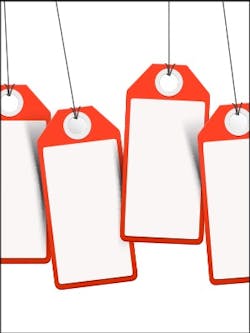Each year, Steve Kiser reevaluates his expenses and tinkers with his gross profit goals to make his business, Kiser Automotive in Needham, Mass., more successful each successive year.
And it all starts with his parts-pricing matrix.
A parts matrix may seem simple on the surface: a spreadsheet that sets mark-up amounts for parts of different prices, allowing a shop operator to achieve a specific gross profit percentage on each part sold.
But the time and planning and budgeting that go into a parts matrix? And the understanding that different parts should allow for different markups and different gross profit percentages? That’s where many shops fail, says Bill Haas, president at Haas Performance Consulting.
Haas and Kiser outline the ins and outs of parts matrices, and what you can do to improve your gross profit margins on parts.
SET YOUR GROSS PROFIT GOAL
Haas recommends shooting for an overall 60 percent gross profit on parts. But, really, your number and how you achieve it is unique to each shop.
“Any shop that’s not setting goals for gross profit on parts is doing it incorrectly,” Haas says. “It starts with having that goal. It starts with knowing what you need to make in order to sustain or grow the business.”
Haas says to start each year with a budget that includes the expected expenses you’ll incur, and then break those expenses down by month, week, day—even by hour. Depending on what your overall goals are for gross profits, that breakdown will aid in constructing the parts matrix.
When it comes to setting his yearly gross profit goals, Kiser adds up every expense from the past year—insurance, taxes, labor, utilities, all the way down to pencils and paper—and adds 15 percent for increases, just to be safe. He divides his expected costs by the number of days the business will be in operation for the year (excluding holidays and weekends), which tells him exactly how much he needs to make in sales per day ($1,500 is the target) to reach an endof- the-year goal of 60 percent gross profit on parts.
While that might seem elaborate, Haas says that sort of planning can turn a rudimentary parts matrix into a great one.
“Unfortunately, for a lot of shops, their accounting is based on what came in,” Haas says. “When really, your accounting should be based on: ‘What do I need to bring in?’”
Parts Markup Matrix
BUILD THE MATRIX
Each matrix (visit bit.ly/rwpartsmatrix to view Haas’ sample parts matrix) should be unique to each individual shop and its gross profit goals, but some basic rules on markups do apply:
Don’t apply a blanket markup amount on parts. While your goal might be to make a 60 percent gross profit on parts, you wouldn’t necessarily apply a markup of 150 percent to all parts. “The reason that doesn’t work is if you were to buy a remanufactured transmission for $1,200 and you multiplied it by 2.5, you’d never be able to sell it,” Haas says. “What I want to do is have a mix at both ends of the spectrum. My hope is to meet in the middle and achieve my target.”
Your greatest gross profit margins are achieved on inexpensive parts. For parts that cost $1 or less, Haas recommends charging the consumer 3.5 times the cost, allowing for a gross profit percentage of 71 percent. For parts that cost between $1 and $5, he says to charge three times more for a gross profit of 67 percent. “Say you use five hose clamps a day, and you say, ‘Forget it, I’m not going to charge for it. It’s worth $2,’” Kiser says. “Ten dollars a day doesn’t sound like much, until you put it over the course of a year. Then it’s a huge amount of money.”
The gross profit percentage decreases as part costs go up. As the price range for parts purchased by your shop increases, your average markup should go down:
• $5–$75: 2.5 times the cost for a 60 percent gross profit
• $75–$150: 2.25 times the cost for a 56 percent gross profit
• $150–$300: twice the cost for a 50 percent gross profit
• $300–$1,000: 1.85 times the cost for a 46 percent gross profit
• Anything over $1,000: 1.75 times the cost for a 43 percent gross profit
Charge more for dealer parts. Since dealerships mark up the parts they sell your shop, Haas says to apply an extra 1.33 multiplier to the normal marked up price. “My experience has been when we take the dealer’s list price and multiply it by 1.33, that actually is very competitive with the actual selling price if that part was installed and sold out of their service department,” he says.
ADJUST THE MATRIX
Once you’ve gone through the process of building the parts matrix, it’s important to stay on top of it and adjust it based on external factors.
Evaluate the matrix based on workload. Knowing his daily gross profit goals allows Kiser to adjust his parts matrix each and every day. If he’s having a slow week, a tiny increase on markups can help him get back on track.
“You’ve got to watch the matrix. It’s not etched in stone,” he says. “If you are having a slow week, you edge the numbers a little bit. You wouldn’t charge $36 for a spark plug that you normally charge $18 for, but you do move things around.”
Break down your parts by category. That way, you can see where you are or are not getting your profits from and can then adjust your matrix accordingly.
“Some parts cannot be applied across the board and make the matrix a little trickier,” Haas says.
For example, tires are difficult to apply within a matrix, he says, since there are stores that specialize in tires and can offer more competitive prices. Raising your markups on tires can justify the cost of purchasing new ones.
“If somebody down the street wants to do that job and charge the person $100 to mount and balance four tires? Good luck,” Kiser says. “I can make more money not doing the job.”
Conform your markups to your specialties. Since higherpriced items have lower markups, a transmission specialist would have a lower average gross profit margin than a generalist who mixes in smaller parts with higher markups. The transmission specialist would have to charge slightly more to reach a goal of 60 percent.
Be aware of your competitors, but don’t base your pricing structure off them. While you should definitely be aware of your competitors’ markups on parts, completely upending your markup system could actually cost you money in the end. “Unfortunately, people are of the mindset that, ‘I will have more business if I’m cheaper,’” Haas says. “But that is so far from the truth. That’s not what people are looking for. They want to find a place where they have confidence their car will be fixed right the first time, on time. “The basis for your price structure is knowing your true cost to do business, and making sure you can cover those costs and make a profit.”

